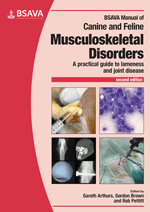
Full text loading...

This chapter assesses different approaches to lameness investigation, covering key causes of lameness, history-taking, hands-off examination, hands-on examination, examination of the thoracic limb, examination of the pelvic limb and common methods for further investigation to reach a definitive diagnosis.
Lameness examination, Page 1 of 1
< Previous page | Next page > /docserver/preview/fulltext/10.22233/9781910443286/9781910443286.2-1.gif

Full text loading...




